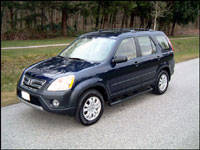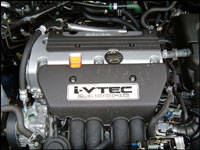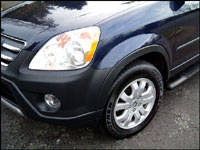Frugality for an Active LifestyleWhile maximizing economy and practicality, the CR-V embodies
 |
| CR-V SE model comes with running boards, sixteen inch wheels, skid plates and a roof rack. (Photo: Rob Rothwell, Canadian Auto Press) |
many yearned-for features of the outdoorsy type, such as Honda's RealTime four-wheel drive (4WD) technology, 16-inch alloy wheels, front and rear skid plates, sidestep bars, plenty of cargo space, trailer pre-wiring and a roof rack. Interestingly all that gear is reserved for Canuck buyers. In the U.S. the base CR-V is a front-wheel-drive unit (FWD), sans the alloy wheels, skid plates, sidestep bars, pre-wiring and roof rack. South of the 49th, the extra traction of RealTime 4WD is available as an option on the base CR-V and as standard equipment further up the trim-level food chain. Except for the 16-inch alloy wheels, which also come as standard packaging in the U.S. with higher trim levels, the remaining Canadian add-ons are available in the U.S. as dealer-installed accessories. When it comes to horsepower, however, all things are equal in both great nations.
The
 |
| 156 horsepower is enough to move the CR-V, especially when it's mated to the standard five-speed manual. (Photo: Rob Rothwell, Canadian Auto Press) |
only engine to power a 2006 CR-V is a peppy 2.4-litre 16 valve, DOHC inline 4-cylinder mill capable of 156 horsepower and 160 foot-pounds of torque. Those are decent figures for a 4-banger and are due in part to Honda's intelligent variable valve timing mechanism, known as i-VTEC. Albeit this isn't the quietest or most refined inline-4 to find its throttle under my right foot, it does rate high on the scale. Within normal operating parameters it demurely fulfilled its tasks, however when pushed hard, which was necessary to generate snappy acceleration or effective passing power, the engine exposed its roots with harmonics typical of a 4-cylinder powerplant. What heft it did manage, at least in my tester, flowed through a short-throw 5-speed manual gearbox, giving some advantage to the limited availability of torque; which peaks at 3,600 rpm - 5-speed automatic transmission is optional. On the flip side of the CR-V's moderate on-ramp performance is its fuel efficiency.
The RealTime 4WD equipped CR-V with an automatic
 |
| Despite being tall and SUV-like, CR-V returns a reasonable 10.6 L/100 km. (Photo: Rob Rothwell, Canadian Auto Press) |
5-speed transmission will travel 100 kilometres of city roadway on only 10.6 litres of fuel. A hundred kilometre highway stint will consume 8.0 litres of the golden nectar. These are impressive figures for an SUV capable of carrying five adults and plenty of gear, and must be kept in mind when sinking the right foot in search of hustle.
Honda has maximized the CR-V's cargo capacity by adhering to a "boxy" exterior design in its latest CR-V styling go-around. I was quite enthused with the huge opening and voluminous cargo bay waiting behind the CR-V's rear door, which by the way is hinged on the passenger's side. Although the unencumbered opening makes loading effortless, swinging the rear door wide open results in an obstruction to curbside. For the North American market it would have been preferable to hinge the door to the driver's side of the vehicle. Happily, Honda had the forethought to install a top-hinged rear window making it oft unnecessary to open the big rear portal.





